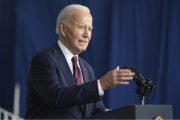
JFK Air Traffic Control to Alitalia Flight 608: Uh, what did you see?
Alitalia to JFK: We saw a drone, a drone aircraft.
JFK to Alitalia: What altitude did you see the aircraft?
Alitalia to JFK: About 1,500 feet.
That was the harrowing exchange from March 4 between an air traffic controller at New York City’s JFK International Airport and a commercial airliner about to land there.
The conversation and the close encounter take on an even more frightening aspect given the Obama administration’s claim that the president is empowered in an “extraordinary circumstance” to deploy drones to assassinate targets within the United States.
Despite several days of investigation by the Federal Aviation Administration (FAA) and the FBI, there are still more questions than answers surrounding the drone sighting and the near collision over Queens in New York City, a borough with a population of over two million.
Some of the details of the event are known, however. When Alitalia Flight 608 was on its final approach about three miles from JFK runway 31R, the pilot saw a black drone powered by four propellers and about three feet in diameter. According to the pilot’s account of the sighting, the drone flew within 200 feet of the plane full of passengers.
Questions: Who was controlling the drone? Why was it flying dangerously close to a commercial jetliner? Who owns the unmanned aerial vehicle? Who issued the license? Who knew of its flight path?
The FAA is the federal agency charged with issuing licenses for domestic drone controllers, but it claims it knows nothing about the drone in question.
The FBI says it’s in the dark, too.
“The FBI is asking anyone with information about the unmanned aircraft or the operator to contact us,” said Special Agent John Giacalone in statement released after the incident. “Our paramount concern is the safety of aircraft passengers and crew,” he added.
Adrian Chen writing for Gawker wonders if the drone might be a hobby craft owned by an individual rather than one controlled by the state or federal government or law enforcement. There is some evidence pointing toward a privately-owned hobby craft as The Week reports that “JFK is just a few miles from Floyd Bennett Field in Brooklyn, an airstrip frequented by remote-control plane aficionados. “Maybe one of those hobbyists decided to flout the FAA’s rule that remote-controlled aircraft stay under 400 feet and stay in sight of the operator, who has to notify air traffic controllers if the aircraft will fly within three miles of an airport,” adds the story.
There might be something to that, however; there are thousands of drones flying over the skies of cities and towns all over the United States without FAA licenses.
Domestic entities are supposed to obtain the FAA licenses, which will not be issued until 2015, despite efforts to accelerate that timetable.
Special exemptions from the 2015 license date are available from the FAA, however. For example, NBC reports that the Mesa Count Sheriff’s Department has been flying drones since 2009 under one of these exemptions.
The never-ending “War on Terror” has helped drive rapid improvement in the technology propelling these drones, as well as the optics with which they are equipped. War is good for business and business is booming.
Data released by Teal Group, an aerospace and defense market intelligence analysis organization, estimates that “the global UAV market will nearly double over the next decade” to $11.4 billion.
While much of that money will be spent domestically, the Teal Group report indicates that the Asia-Pacific area will be the “second largest market, followed very closely by Europe.
As The New American reported last year, President Obama notified Congress that he intended to sell missiles to arm American-made Predator and Reaper drones owned by Italy, the United Kingdom, Poland, and other European countries.
A report published recently in Daily Kos describes the scope of the European drone market and the cost to U.S. taxpayers of arming the European drones.
[General Atomics and Aeronautics} has been contracted to provide drones for Italy, the United Kingdom, Poland, and other countries. Who pays for the drones that are shipped to foreign governments is probably the best kept secret of the entire program. The US maintains a Foreign Military Sales program that isn’t very transparent. Billions of dollars worth of military equipment of all descriptions is delivered to a list of qualified countries, free of charge to them, billed to the US taxpayers. A partner program, Foreign Military Financing, helps countries pay for their military needs. It all adds up to lucrative business for military contractors.
How do billions of dollars of taxpayer money get sent overseas for the arming of the drones owned by foreign armed forces? General Dynamics and the fellow drone manufacturers have deep pockets and they throw that money around at election time, depositing millions into the campaign coffers of key congressmen.
A collaboration between Hearst Newspapers and the Center for Responsive Politics paints the pecuniary picture:
The drone makers have sought congressional help to speed their entry into a domestic market valued in the billions. The 60-member House of Representatives’ “drone caucus” — officially, the House Unmanned Systems Caucus — has helped push that agenda. And over the last four years, caucus members have drawn nearly $8 million in drone-related campaign contributions….
And:
House members from California, Texas, Virginia and New York on the bipartisan “drone caucus” received the lion’s share of the funds channeled to lawmakers from dozens of firms that are members of the Association for Unmanned Vehicle Systems International, Hearst and CRP found.
Eleven drone caucus lawmakers from California, where many aviation firms are located, received more than $2.4 million from manufacturers’ political action committees and employees during the 2012 and 2010 election cycles, according to CRP tabulation of Federal Election Commission reports.
Eight Texas House members in the caucus received more than $746,000. And four caucus members from New York got more than $185,000 from companies connected to the business of unmanned vehicles.
The big winner of the drone manufacturer lobbying lotto was Representative Howard “Buck” McKeon (R-Calif.). According to the investigation, McKeon — cochairman of the House Unmanned Systems Caucus — received $833,650 in contributions from the drone industry.
Given the amount of money flowing between the drone makers and the lawmakers, it is odd that most Americans have never heard of the Unmanned Systems Caucus.
General Atomics, maker of the Predator drone, is among the top three all-time campaign contributors to Congressmen Calvert, Lewis, and McKeon.
In 2010 and 2012, General Atomics’ PAC has paid out over $140,000 in donations to drone caucus members representing states located on the border with Mexico.
And, as Daily Kos reports:
In the 2012 election cycle, it was a donor of $504,950 to various political candidates. James Neal Blue [CEO of General Atomics] was also a contributor to various campaigns. The company PAC campaign donations broke down to 39% for Democratic candidates and 61% for Republican candidates. Notable on the list: Buck McKeon, the Republican representative from the Santa Clarita Valley district north of Los Angeles. He sponsored the 2012 and 2013 NDAA measures in the House. The entire political spectrum is included in the list of recipients, from Mitch McConnell, and John Boehner, to Sherrod Brown and Kirstin Gillibrand.
General Atomics isn’t the only one greasing the skids, however. A PAC largely financed by Northrop Grumman contributed about $150,000 to 16 congressmen in the drone caucus who represent districts in California, Texas, Arizona, and Nevada.
Drones are becoming a part of American culture and millions of dollars are being spent by the manufacturers to make sure the law facilitates future flights.
The drone flight over New York City came within 200 feet of becoming a fiery tragedy. The lives of hundreds or thousands could have been ended by the collision of a commercial airliner with a drone nobody seems to know anything about.
American citizens are right to worry and are justified in demanding answers from those who have oversight into the use of these never-blinking eyes in the sky. Particularly when they come so close to killing innocent civilians and the federal government is ready to greenlight the launch of thousands more in the near future.
Joe A. Wolverton, II, J.D. is a correspondent for The New American and travels frequently nationwide speaking on topics of nullification, the NDAA, and the surveillance state. He can be reached at [email protected].



